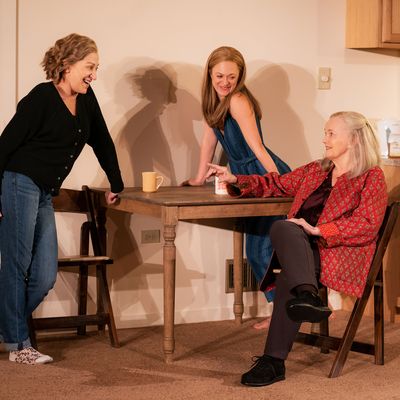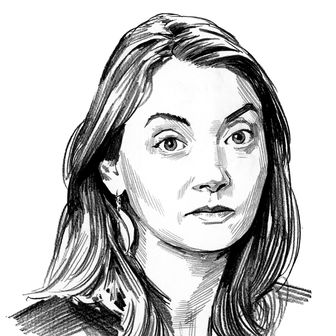
In the new drama Morning Sun by Simon Stephens, a young single mother, desperate for places to walk in New York, starts going to museums, wandering the galleries with the baby in her stroller. One day, she stops in front of the Edward Hopper painting Morning Sun. The gallery guard strikes up a conversation, which leads to one of the sad episodes of the woman’s not-entirely-sad life, the subject of Stephens’s not-entirely-sad play.
I did a little searching around, and it turns out that Morning Sun — Hopper’s lapidary painting of a woman looking out her window — actually hangs in Columbus, Ohio. What New York has are the iterative studies. If you go to the Whitney’s website, you can see three drawings Hopper did as he changed a recognizable sketch of his wife into one of his flat-affect illustrations of human isolation. Stephens wants to find the elegant, lonesome quality of the finished painting, so to get there, he uses a theatrical version of the studies’ stepwise, scribbly, charcoal progression.
The show doesn’t have scenes, exactly. Instead it’s a three-way conversation among women who are, perhaps, reminiscing, though their knowledge goes beyond the limits of the grave. The three women in Morning Sun are listed in the script as 1, 2, and 3, though we come to know them (mostly) as Charley McBride (Edie Falco); her mother, Claudette (Blair Brown); and Charley’s daughter, Tessa (Marin Ireland). In an intermission-less 100 minutes, Stephens lays out more than a half-century of their lives, starting with Claudette’s move to New York in 1947 and ending … as any life history does.
It’s really Charley’s tale; we only learn enough about Claudette and Tessa to understand her behavior as a daughter and a mother. There’s all of the real world to reflect too, so Charley works for decades at St. Vincent’s hospital, where she sees both the AIDS crisis and 9/11 up close. (Life told this way is basically a catalogue of losses.) The three women recite a swift, sketching path through their memories, all narrating the story, sometimes agreeing, sometimes making corrections. Here, for instance, are Charley and Claudette talking about Charley’s childhood on 11th Street:
I do remember some things.
—I bet you do.
The smell of Daddy’s shirts. I remember the clean smell of his shirts.
—I cleaned them.
And the noise of the street and you warning me to be careful of the traffic.
—You never listened to me.
I did.
Other characters surface in the story, and the three actresses play them too. (Ireland is Charley’s childhood friend for a moment or two, for instance.) The trio of superstars seem to have been cast for their flexible voices — all three can plunge down the octave, changing to be the men who know Charley, then returning to their usual registers again. The script is a showcase for bravura performances, and it capitalizes on how completely the women can pivot among opposing facets of a personality. Falco manages to be both swaggering and mid-collapse for the whole 100 minutes. Brown radiates empathy, but her Claudette can be dagger-sharp, telling Charley — without altering her sweet, for-your-own-good tone — that she’s a bad mother. Ireland speaks in a wonderfully impervious drawl, which makes the difficult material seem effortless, yet her breeziness disappears for a long moment when Tessa takes Charley by the shoulder to say that she knows her mother tried. Ireland’s shift into seriousness is breathtaking. The show seems to stop in its tracks until Charley nods, understanding that she’s been forgiven.
Stephens is dealing with the revelations that are only possible in limbo (like whether your mother ever truly saw you), so he places the women in a liminal space his script describes as being “defined more by light and sound than by objects.” Director Lila Neugebauer interprets that to mean not abstraction but somewhere recognizable. The set-design collective Dots (Kimie Nishikawa, Andrew Moerdyk, and Santiago Orjuela-Laverde) built her a carpeted basement with a low ceiling and glass brick that lets in Lap Chi Chu’s long, horizontal shafts of light. The dark wood benches and stacks of folding chairs tell us we’re downstairs at a church or a funeral home — somewhere neutral where people prepare to grieve. Neugebauer is the director to handle such psychological spaces: Whether in the devised work she made with The Mad Ones or the shows she’s directed since then (Adrienne Kennedy’s Funnyhouse of a Negro, Kenneth Lonergan’s The Waverly Gallery), she exactly understands how to illuminate eerie in-between places that are also, somehow, mental states.
In such a theatrical not-world, it’s hard to think of Stephens’s 1, 2, and 3 without also thinking of Edward Albee’s A, B, and C from his Three Tall Women. In Albee, the three represent the same person at three ages, whereas in Stephens they are three generations of family. The effect, though, is similar. The multiple perspectives on a life become triple spotlights trained on a sculpture, giving it dimension and weight. Certainly light and its absence is what you spend most of Morning Sun thinking about. The play starts with a confusing barrage in the dark — the women speaking lines that seem to be what we hear on our deathbed. (“Hold her head up!” says someone.) Then, when dawn breaks through the glass blocks, the story begins. In the brief moment between two blackouts, a life flashes before our eyes. Is that really all it is? I have been poring over the text since I saw the show, trying to understand how Stephens made such an emotionally effective piece. I’ve been baffled. On the page, it doesn’t seem to contain much spark, but I know I remember how gorgeous it was. The secret must lie in whatever alchemy the company is making onstage. Appropriately enough, to feel their impact, you’ve got to get in the room with those actors. There is no substitute for life.
Morning Sun is at City Center Stage I through December 19.


